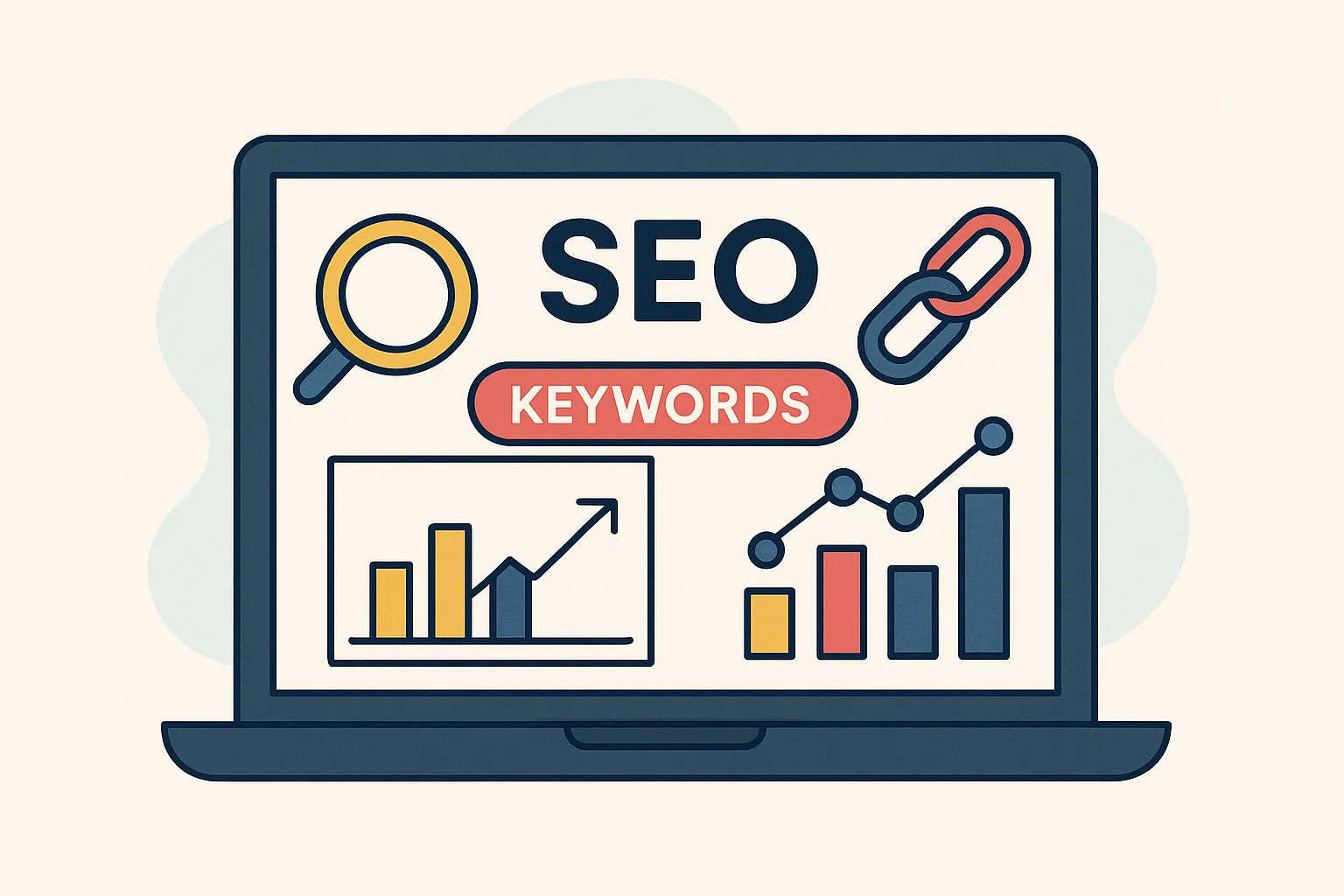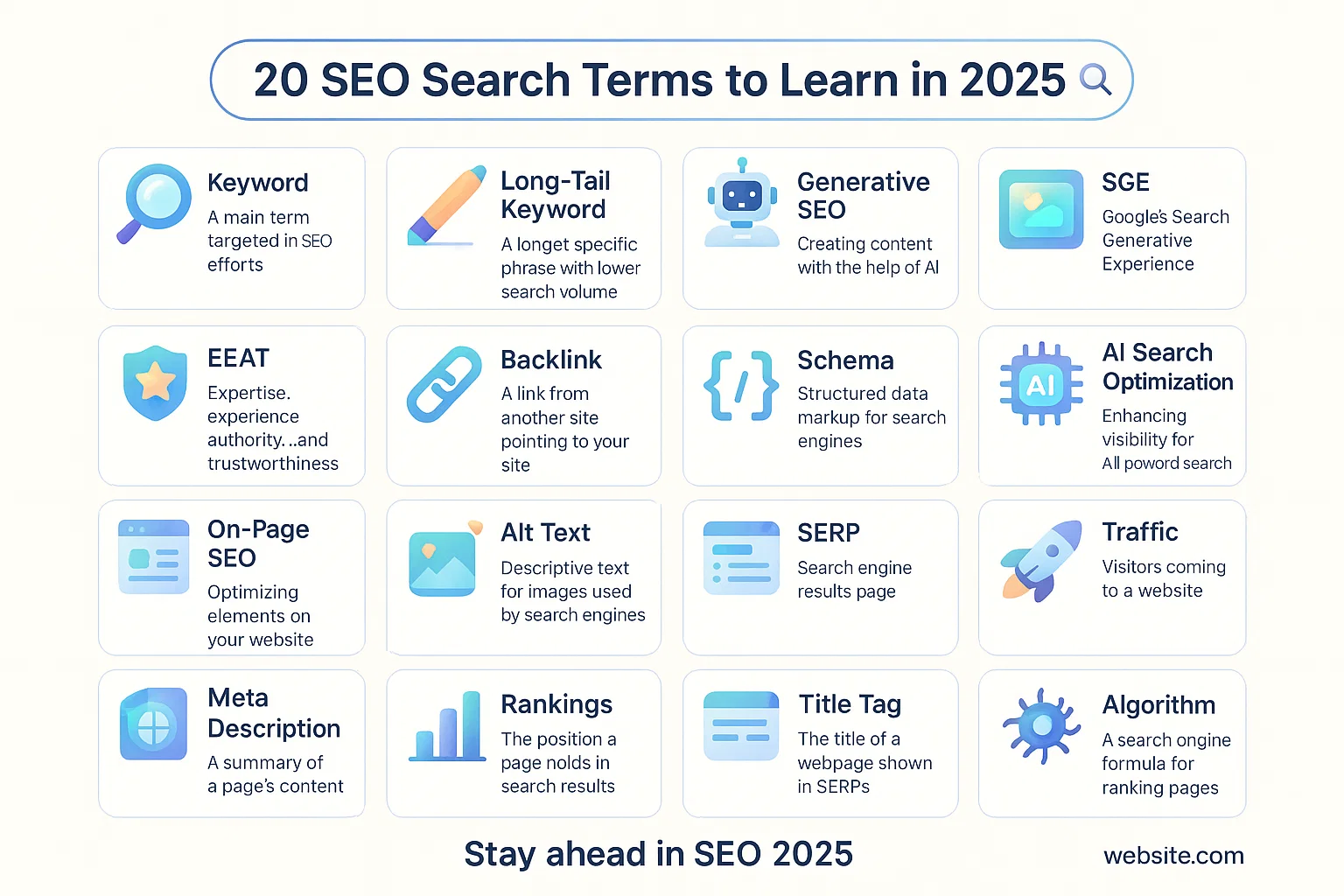
I’m breaking down the 20 most important SEO search terms you need to know this year. Some are timeless basics, others are brand new thanks to Google’s Search Generative Experience (SGE) and AI. By the end, you’ll be speaking SEO fluently , and maybe even teaching it to your friends.
1. Keyword
A keyword is what a person types into a search engine. Sounds simple, but here’s the trick: the right keyword connects your content with the exact people you want to reach. Without it, you’re throwing words into the void.
In 2025, keywords aren’t about stuffing the same phrase a hundred times. Google’s smarter. It recognises synonyms, context, and intent. For example, if someone searches “cheap flights,” Google also shows pages about “budget airfare” or “low-cost airlines.”
So instead of obsessing over exact matches, think about the overall topic. Tools like Google Keyword Planner, Ahrefs, or even autocomplete in Google can help you spot the words your audience actually uses.
Pro tip: Use keywords naturally, like seasoning in food. Too little, and your dish tastes bland. Too much, and it’s ruined.
2. Long-Tail Keyword
If keywords are the foundation, long-tail keywords are the hidden gems. These are longer, more specific search phrases like:
“best budget smartphone under $300 in 2025”
“how to fix WordPress error could not insert attachment”
Why do they matter? Because fewer people compete for them. That means higher chances of ranking , and attracting visitors who are closer to buying or taking action.
Imagine this: someone searching “shoes” might just be browsing. But “best trail running shoes for wet conditions” screams intent. That’s where conversions happen.
In 2025, long-tail keywords are even more important because AI-driven search loves detailed, context-rich content. The more specific your content, the more likely AI tools will recommend it in summaries.
3. Generative SEO
This is the buzzword of 2025. Generative SEO is optimising content not just for traditional search results but for AI-generated answers. Google’s SGE, Bing Copilot, and ChatGPT-style responses now summarise results at the top of search.
What does that mean for you? Your content needs to be structured in a way AI can “understand” and pull from. Use clear headings, bullet points, and factual statements. Think of it like leaving breadcrumbs for AI.
Example: Instead of writing one long messy paragraph, break it down:
What is Generative SEO?
Why it matters in 2025
How to optimise for it
If AI assistants find your content reliable, they’ll quote or reference you in summaries , bringing traffic your way.
4. SGE (Search Generative Experience)
Google’s SGE is changing everything. Instead of the old 10 blue links, search results now include an AI summary at the very top. It’s like Google answering your question before you even click.
That sounds scary for bloggers, right? Fewer clicks. But here’s the flip side: if your content gets cited in that summary, you’re instantly trusted by thousands of users.
How to show up there?
Answer questions directly.
Use structured headings.
Add fresh, updated content.
In 2025, SEO isn’t just about “ranking” , it’s about becoming part of the AI’s chosen sources.
5. EEAT (Experience, Expertise, Authoritativeness, Trustworthiness)
This mouthful is Google’s quality test. EEAT basically asks: “Why should we trust you?”
Experience: Have you actually used or lived what you’re writing about?
Expertise: Do you have knowledge or credentials?
Authoritativeness: Do other trusted sites mention or link to you?
Trustworthiness: Is your content accurate, honest, and safe?
Example: If you’re writing about medical advice without being a doctor, you’ll struggle. But if you’re a travel blogger writing about a city you’ve visited, your experience boosts your credibility.
Pro tip: Add author bios, cite reliable sources, and show transparency. EEAT is Google’s way of fighting fake or low-quality content , and in 2025, it’s non-negotiable.
6. Semantic SEO
Forget stuffing keywords. Semantic SEO is about creating content that covers an entire topic with context. Google now connects the dots between related words, questions, and entities.
For example, a page about “electric cars” should naturally include phrases like charging stations, EV batteries, Tesla, subsidies, etc. That tells Google: this page covers the subject in depth.
In 2025, semantic SEO is key for AI-powered search. The more angles and related ideas your page covers, the more likely you’ll show up in summaries.
Pro tip: Use tools like “People Also Ask” and AnswerThePublic to find related questions and include them in your content.
7. User Intent
Behind every search, there’s a goal. That’s user intent. Are they:
Informational: Wanting to learn (“what is SEO”)
Navigational: Looking for a brand/site (“YouTube login”)
Transactional: Ready to buy (“best hosting 2025 discount”)
If your page doesn’t match intent, you’ll rank poorly even if your keywords are perfect.
Example: Someone searching “how to bake bread” wants a recipe, not a history lesson. If you deliver the wrong type of content, they’ll bounce.
In 2025, intent is more important because AI is better at detecting when a page doesn’t match the query.
8. Featured Snippets
Those neat answer boxes at the top of Google? Featured snippets are SEO jackpots. They grab attention and drive clicks.
How to win one?
Answer questions in short, clear sentences.
Use lists, tables, or steps.
Be accurate and concise.
In 2025, featured snippets often feed into AI summaries too. So if you get the snippet, you’re more likely to appear in the new AI search results. Double win.
9. Backlink
Think of a backlink as a digital recommendation. When another site links to you, it’s telling Google: “Hey, this content is worth checking out.”
But here’s the catch: one link from a respected site is worth more than 100 shady ones. In fact, too many spammy backlinks can hurt you.
How to earn them? Publish high-quality content, guest post on trusted blogs, or create something so useful (like a free tool or guide) that people naturally link to it.
In 2025, backlinks still matter , but relevance and authority matter more than sheer numbers.
10. Anchor Text
When you link to another page, the anchor text is the clickable part. Example:
“Read this SEO guide for beginners.”
Google uses anchor text to understand what the linked page is about. But don’t over-optimise. If every link says “cheap hosting 2025,” it looks fake.
In 2025, natural, varied anchor text is best. Mix branded terms, phrases, and even “click here.” Balance is key.
11. Organic Traffic
Organic traffic is the dream. These are people who find your site naturally through search, not through ads.
Why is it valuable? Because you don’t pay per click, and organic traffic often has higher trust.
But organic growth takes time. In 2025, with AI summaries eating clicks, building an audience might mean combining SEO with email lists, social media, and community-building.
Still, nothing beats the steady flow of organic visitors once you rank.
12. CTR (Click-Through Rate)
CTR tells you how many people clicked your link after seeing it in search. If 100 people see your page but only 3 click, that’s a 3% CTR.
Why does it matter? A low CTR means your title or description isn’t appealing. Google notices this and may drop your ranking.
Tips for 2025:
Use numbers (“7 Best Tools for SEO in 2025”)
Add emotional words (“simple,” “fast,” “essential”)
Keep titles under 60 characters so they don’t cut off
13. Bounce Rate
Bounce rate measures the % of visitors who leave after one page. High bounce = bad signals.
But here’s the nuance: sometimes a bounce is fine. If someone searched “weather today” and saw the answer right away, that’s mission accomplished.
Still, if your blog posts are too thin, outdated, or irrelevant, people will bounce. In 2025, focus on keeping visitors engaged with internal links, visuals, and easy-to-read formatting.
14. Conversion Rate
Traffic is nice, but what happens next? That’s where conversion rate comes in. It’s the % of visitors who take a desired action , buying, subscribing, or signing up.
For bloggers, conversions might be:
Joining a newsletter
Downloading a free e-book
Clicking affiliate links
Improving conversions in 2025 is about trust (EEAT), fast pages (Core Web Vitals), and clear CTAs.
15. Core Web Vitals
Google cares about user experience. Core Web Vitals are three key metrics:
LCP: How fast your page loads the main content
FID: How quickly it responds when users click
CLS: How stable the layout is (no jumping ads!)
A slow, clunky site will sink in rankings. In 2025, this is even stricter because mobile-first indexing is now universal.
16. Alt Text
Images aren’t just pretty , they’re SEO opportunities. Alt text is the description you give an image.
Why it matters:
Helps visually impaired users with screen readers.
Tells Google what the image shows.
Can rank your images in Google Images.
In 2025, don’t just write “image of cat.” Be descriptive: “black cat sitting on laptop keyboard.” That detail helps AI and search engines understand context.
17. Robots.txt
The robots.txt file tells search engines which parts of your site to crawl.
If you mess it up, you could accidentally block your entire site from Google (yes, it happens).
In 2025, it’s especially important as AI crawlers become more active. Some sites even block AI bots from scraping content. Knowing how to tweak robots.txt gives you control over who sees your content.
18. Canonical URL
Duplicate content confuses Google. A canonical tag points to the “official” version of a page.
Example:
yoursite.com/page/yoursite.com/page?ref=twitter
Both exist, but you want Google to know which is the real deal. That’s where canonicals save you.
In 2025, with e-commerce and UGC (user-generated content) exploding, canonical tags are crucial for keeping SEO clean.
19. Schema Markup
Schema is code that helps Google “see” what your content means.
Want star ratings in search? Or your FAQ to show under your link? That’s schema.
In 2025, schema is also being used to help AI identify trustworthy, structured content. Adding it boosts your chances of showing up in rich results and AI summaries.
20. AI Search Optimisation
This is the evolution of SEO. It’s not just about humans , it’s about machines too.
AI search optimisation means writing in a way that humans enjoy but AI can also summarise. Think:
Short, factual sentences.
Structured headings.
Verified data.
It’s like writing for two audiences at once: people and machines. And in 2025, if you ignore it, you’ll vanish from AI-driven search.
Final Recap Table
| Term | Why It Matters in 2025 |
|---|---|
| Keyword | Still the base, but intent matters more |
| Long-Tail Keyword | Easier rankings, higher conversions |
| Generative SEO | Optimising for AI answers |
| SGE | Google’s AI-powered results |
| EEAT | Google’s trust test |
| Semantic SEO | Covering whole topics |
| User Intent | Matching content to goals |
| Featured Snippets | Visibility boost + AI source |
| Backlink | Quality over quantity |
| Anchor Text | Helps Google understand links |
| Organic Traffic | Best long-term traffic |
| CTR | Signals content relevance |
| Bounce Rate | Measures user satisfaction |
| Conversion Rate | Turns traffic into results |
| Core Web Vitals | Google’s UX metric |
| Alt Text | Helps SEO + accessibility |
| Robots.txt | Controls crawlers |
| Canonical URL | Prevents duplicate confusion |
| Schema Markup | Adds rich snippets |
| AI Search Optimisation | Future-proof SEO |

Staying Ahead in 2025
SEO isn’t dead , it’s evolving. The only way to stay relevant is to learn, test, and adapt. Bookmark trusted resources, watch industry updates, and keep experimenting.
And if writing SEO-friendly content feels heavy, use smart helpers like an AI Reword Tool to polish your text. Just remember: the best SEO isn’t about pleasing algorithms , it’s about helping people.

Mia Creatives explores the intersection of technology and creativity. Dive into WordPress, SEO, and innovative ways to thrive online.